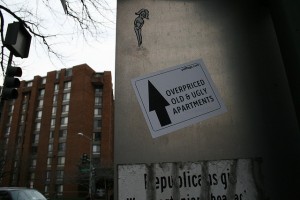Where are D.C.’s Rent-Controlled Apartments?
Rent in D.C. is expensive, and it’s not getting any cheaper. The city does have rent control regulations to help buffer the spike in rates, and a new report by the Urban Institute outlines which wards are most likely to have rent-controlled units.
Lydia DePillis of Housing Complex posted this map, from the report [PDF]. It shows properties that aren’t necessarily under rent control, but do meet the requirements: buildings built before 1978, with five or more units and don’t qualify for exemptions.
The wards with the highest number of properties on the list are the city’s poorest wards, 7 and 8. But look at the number of units themselves, and a different picture emerges: Ward 1 has the most individual units, followed by Ward 3, the wealthiest ward in the city.
As DePillis points out, the report doesn’t:
… tell us anything about the quality of those rent-controlled apartment buildings: How full they are, whether their owners are adhering to regulations, and how many petitions they’ve filed to raise rents beyond otherwise allowable levels. It also doesn’t give us any idea how fast the stock of stabilized units is declining.
Here is the ward breakdown of rental units that meet rent control requirements:
Ward 1: 12,818 units (16.5 percent of total units)
Ward 2: 12,297 units (15.5 percent of total units)
Ward 3: 12,818 units (16.2 percent of total units)
Ward 4: 7,022 units (8.9 percent of total units)
Ward 5: 7,027 units (8.9 percent of total units)
Ward 6: 4,827 units (6.1 percent of total units)
Ward 7: 10,144 units (12.8 percent of total units)
Ward 8: 11,976 units (15.1 percent of total units)





